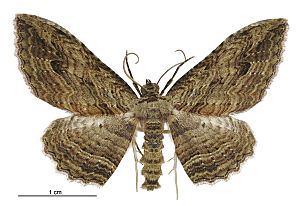Austrocidaria anguligera facts for kids
Quick facts for kids Austrocidaria anguligera |
|
|---|---|
 |
|
| Male | |
 |
|
| Female | |
| Scientific classification | |
| Genus: |
Austrocidaria
|
| Species: |
anguligera
|
| Synonyms | |
|
|
Austrocidaria anguligera is a type of moth found only in New Zealand. It belongs to the Geometridae family, often called "looper moths." This moth is considered uncommon, and people sometimes confuse it with another similar moth called Austrocidaria bipartita.
Contents
How This Moth Got Its Name
The Austrocidaria anguligera moth was first described in 1879. A scientist named Arthur Gardiner Butler gave it the name Phibalapteryx anguligera. He studied moths collected by Frederick Hutton in Dunedin, New Zealand.
Later, another scientist, George Vernon Hudson, wrote about this moth in his books. In 1928, he called it Eucymatoge anguligera. Finally, in 1988, John S. Dugdale placed the moth in a new group, or genus, called Austrocidaria. The original specimen used to describe the species is kept at the Natural History Museum, London.
What This Moth Looks Like
Adult Austrocidaria anguligera moths are often sandy brown in color. They have a distinct slanted, olive-brown band across their middle. This band has a zigzag pattern. There is also a dark spot near the center of their wings.
The veins on their wings are usually white with small black dots. The edges of their hind wings are slightly wavy. Sometimes, this moth is mistaken for A. bipartita, which is a more common species.
Where This Moth Lives
This moth is found only in New Zealand. It has been seen in several places on the South Island, including Canterbury, Otago, Invercargill, and Otira. It also lives on the North Island, in areas like Auckland and Wellington.
Life and Habits
Adult Austrocidaria anguligera moths are active from September to March. During the day, you might find them resting quietly on tree trunks or fence posts.
Home and Food
This moth prefers to live in scrubby forest areas. It can be found in different types of environments, from mountain regions to coastal areas.
The young moths, called larvae or caterpillars, eat plants from the Coprosma family. Adult moths have also been seen feeding on the flowers of Senecio species and Hebe salicifolia plants.

